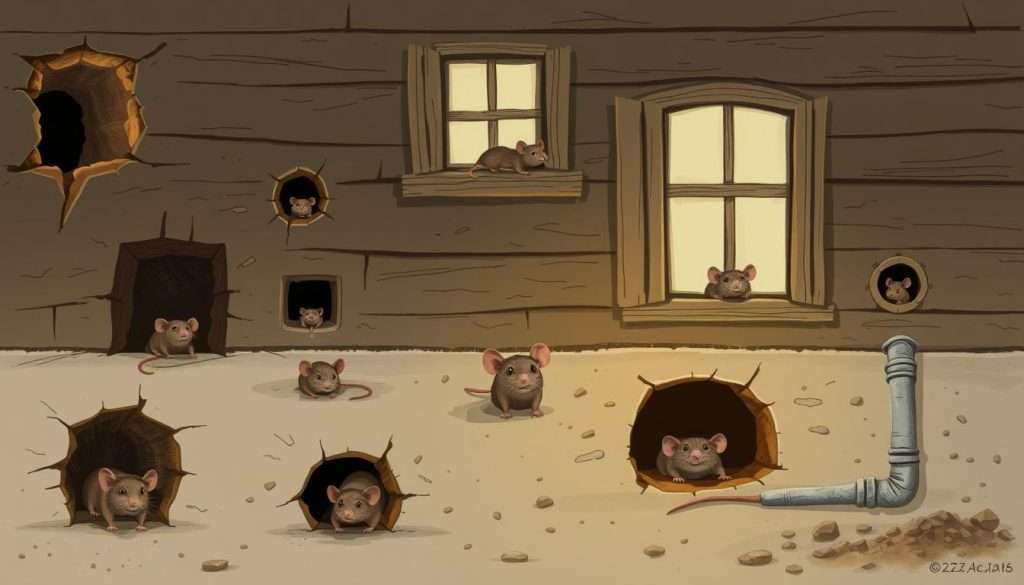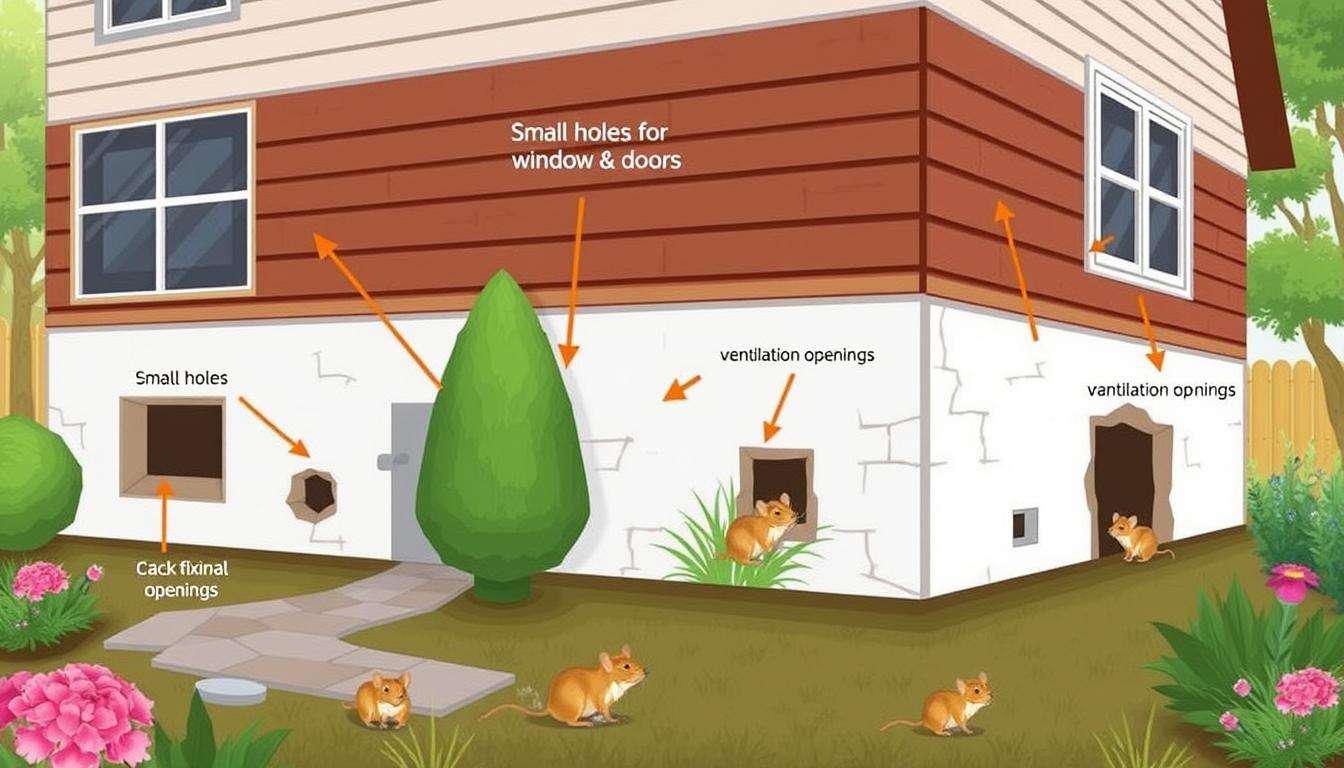Mice, especially the common house mouse (Mus musculus), are common in many homes in the United States. They seek shelter indoors as it gets colder, especially in fall and winter. Knowing how mice get into your house is key to stopping them.
These rodents can cause problems with food and health. An adult mouse only needs a little food each day. They like warmth and convenience, often going to appliances like refrigerators and dryers.
To keep mice out, you need to know their entry points and habits. By using mice prevention tips and learning about rodent control, you can protect your home.
Key Takeaways
- Mice can enter through openings as small as a quarter-inch.
- Proper food storage is critical to preventing mouse attraction.
- Regularly inspect your home for potential mouse entry points.
- Professional pest control can be essential for effective management.
- Mice can reproduce rapidly, leading to larger infestations.
- Using traps can effectively control mouse populations when used correctly.
Understanding the House Mouse
House mice are interesting creatures that live with humans. To manage them well, we need to know how to spot them and what they like. Let’s dive into these topics.
Identification and Characteristics
Finding a house mouse is easy because of their unique look. They are 5 ½ to 7 ½ inches long, with a 3 to 4 inch tail. Their colors range from gray to brown. Here are some key traits:
- Large ears and small eyes
- Sleek, thin bodies weighing around ½ ounce
- Sharp teeth for gnawing
These mice are smart and can live well in homes. They like to hide in safe spots.
Behavior and Habitat Preferences
Knowing how mice act is key for homeowners. They like to hide in spots like behind appliances or in walls. They are most active at night but may come out during the day if hungry. They can fit through tiny openings, making it easy for them to get into homes. Here are some behaviors and preferences:
- Active all year, looking for warmth and safety in cold months
- Can jump up to 12 inches from the ground
- Can have 5 to 10 litters a year, fast breeding
Because they adapt quickly, a few mice can turn into a big problem fast.
How Do Mice Get In Your House
To keep mice out, know where they can get in. Their small size and agility help them sneak into homes. Sealing up holes can greatly lower the chance of mice showing up.
Common Entry Points for Mice
Mice find many ways to get into homes. They use:
- Cracks in foundations
- Gaps around doors and windows
- Openings for pipes and wires
- Thresholds with large gaps beneath doors
- Unsealed garage doors and vents
It’s amazing how small a hole a mouse can fit through. Even a ¼ inch gap is enough. Using steel wool and caulk can block these holes well. Pay extra attention to plumbing and HVAC areas. Regular checks can spot new mouse entry points.
Size and Agility of Mice
The size and agility of mice help them get into homes. Adult mice weigh 5 to 10 ounces and are 7 inches long. They can jump up to 13 inches and climb well.

Since mice can get into many places, stopping them needs careful work. Check and fix your home’s damage often. Also, throw away food and trash properly to keep them away.
Recognizing Mouse Infestation Signs
Spotting mouse infestation signs is key to acting fast. Different signs can tell you if mice are in your home. Knowing these signs helps you take action quickly to prevent damage and health issues.
Common Signs of Infestation
Some clear signs of mouse infestation include:
- Mouse droppings: These are ¼ inch long and look like grains of rice. Fresh droppings are shiny and soft. Older ones are hard and crumbly.
- Gnawed packaging: Mice chew on food packages. They shred materials as they search for food.
- Greasy smear marks: Dark marks on walls or floors show where mice often go.
Visual Indicators of Mouse Presence
There are many visual signs of mice:
- Nesting materials: Mice use paper, fabric, or insulation for nests. These are often in hidden spots.
- Strong urine odor: A strong, musky smell means mouse urine is around. This smell is common where mice are active.
- Unusual behavior in pets: Cats and dogs might act strange if they sense mice.
Mice Prevention Tips for Homeowners
To keep your home mouse-free, focus on cleanliness and sealing entry points. Here are some tips every homeowner should know.
Sanitation and Cleanliness
Keeping your home clean is key to stopping mice. Here’s how:
- Store food in air-tight containers to keep it away from mice.
- Clean kitchen surfaces often to remove crumbs and spills.
- Get rid of pet food and leftovers at night to stop mice from getting them.
- Wash dishes and utensils right after you use them to get rid of food bits.
Sealing Entry Holes Effectively
It’s important to find and seal any holes mice could use to get in. They can fit through tiny spaces. Here’s what to do:
- Look for cracks and gaps, especially around pipes, doors, and windows.
- Use steel wool, caulk, and hardware cloth to block holes bigger than ¼ inch.
- Make sure doors and windows close well to keep mice out.
- Keep compost bins and woodpiles at least 100 feet away from your house to stop mice from nesting there.
By using these tips, you can lower the chance of mice getting into your home. This makes your living space more comfortable.

Eliminating Food Sources for Mice
Getting rid of food sources is key to controlling mice. Keeping your home clean of food helps a lot. This includes storing food right and keeping pet food safe from mice.
Proper Food Storage Practices
It’s important to store food well to fight mice. This is especially true for foods mice love.
- Use strong, sealed containers for grains, snacks, and dried foods. Don’t use plastic bags or cardboard, as mice can chew through them.
- Store fruits like bananas, apples, and oranges in sealed bins, not on counters.
- Throw away food waste in locked trash bins to cut down on food for mice.
- Make sure leftovers are covered and stored right to stop mice from finding food.
Preventing Access to Pet Food
It’s also key to keep mice away from pet food.
- Put dry pet food in sealed bins, not in open packaging.
- Don’t leave pet food out at night. Clean and dry pet bowls to get rid of food bits.
- Check the pet food area often for mouse signs.
Effective Rodent Control Methods
Managing mouse invasions can greatly improve your home. Trapping and using mouse repellents are key methods. Each has its own strengths for keeping your space mouse-free.
Traps: Types and Uses
Trapping is a popular way to control mice. There are many types of mouse traps:
- Snap traps: Quick and efficient, these traps kill mice instantly upon capture.
- Live traps: Designed to catch mice alive, allowing for release in a different location.
- Glue traps: A sticky surface captures mice but can be considered inhumane by some.
Place traps in areas with mouse signs. Set them along walls where mice travel. Keep traps 10 feet apart for better capture chances.
Mouse Repellents and Their Effectiveness
Mouse repellents, natural or synthetic, can keep mice away. Peppermint oil and clove have strong smells mice don’t like. Use them with sealing entry points and cleanliness for best results.
| Trap Type | Effectiveness | Humane Option | Cost |
|---|---|---|---|
| Snap traps | High | No | Low |
| Live traps | Moderate | Yes | Medium |
| Glue traps | Moderate | No | Low |
| Mouse repellents | Variable | Yes (natural options) | Low to medium |
Using a mix of rodent control methods is key. It leads to a more effective strategy against mice.
Conclusion
Knowing how mice get into your home is key to keeping them out. Start by keeping your home clean and removing food that mice like. Seal up small holes and gaps to block their way.
Using traps and repellents can help too. But, staying alert is the most important thing to keep mice away.
Mice can quickly become a big problem because they breed fast. A single female can have dozens of babies in a year. This can turn a small issue into a big one fast.
It’s important to watch your home for mice signs and act fast. For tips on finding where mice might get in, check out this useful resource.
If mice keep coming back, it might be time to call a pest control service. Taking a complete approach to mouse control helps keep your home safe and welcoming.
